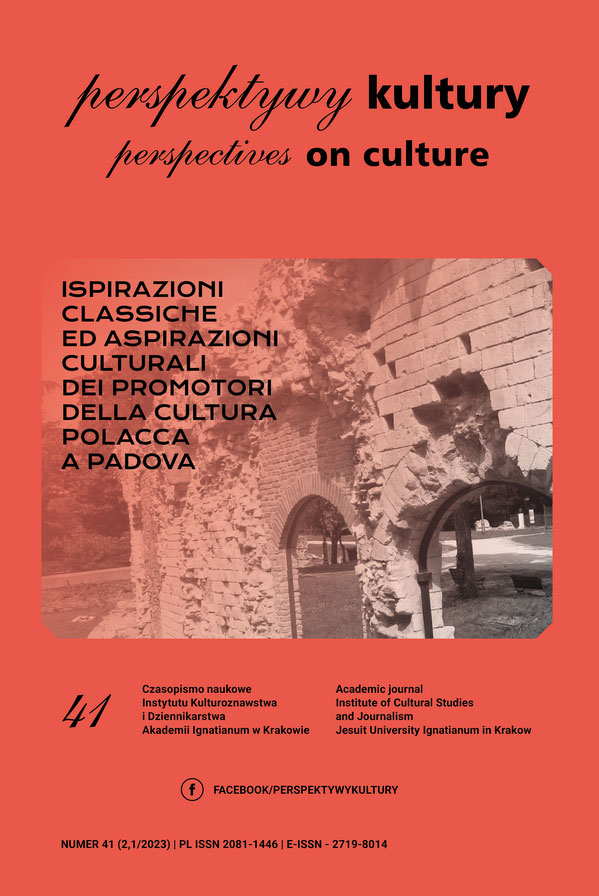Antica tradizione, leggenda medievale e gloria del nome Polacco nella prima età moderna
Stanisław Temberski e la sua Tiara episcopalis
Abstrakt
Lo scopo principale dell’articolo è quello di analizzare il discorso latino pubblicato a Padova nel 1642 e pronunciato davanti alla solenne assemblea della nazione polacca presso l’Università di Padova, nella chiesa di Sant’Antonio da Padova, il 7 maggio dell’anno precedente. L’autore del testo fu Stanisław Temberski, canonico e professore all’Università Jagellonica. L’autore dell’articolo presenta brevemente la sua biografia e la sua opera letteraria, quindi analizza il discorso. Evitando valutazioni di carattere letterario del lavoro in quanto tale cerca di presentare le idee in esso contenute e di mostrare come la cultura umanistica caratteristica della prima età moderna permetta all’autore di costruire formule e immagini eloquenti che glorificano il nome della sua patria lodando la gloria del suo santo. La lode della Polonia è inestricabilmente legata alla lode del suo patrono, San Stanislao, vescovo e martire. Nell’orazione di Temberski la tradizione antica e medioevale, la leggenda agiografica sono intrecciate e tutto è elaborato secondo la mentalità dell’autore e i concetti della retorica seicentesca. Il santo martire viene paragonato ad Ercole e il malvagio tiranno responsabile della sua morte viene ritratto come uno strumento di Satana, percepito come “Cerbero infernale”. L’uso che Temberski fa delle sue doti retoriche a fini propagandistici è degno di nota: da un lato manifesta la sua cultura umanistica e si presenta come cittadino della Respublica litteraria, dall’altro, inscrive lo Stato polacco nella lunga tradizione della Respublica Christiana. In questo contesto, mette in evidenza che un Paese che produce uomini così pii ed eroici come il santo vescovo è degno di apprezzamento tra le nazioni d’Europa.
Bibliografia
Barycz, H. (1965). Padwa siedemnastowieczna w życiu intelektualnym Polski. In: H. Barycz, Spojrzenia w przeszłość polsko-włoską. Wrocław–Warszawa–Kraków: Ossolineum, 352–384.
Besz, Z. (1922). Stanisława Temberskiego związki z Przemyślem. Życie Przemyskie, 2(12), 5.
Czermak, W. (1897). Introduzione. In: S. Temberski. Roczniki 1647–1656. Kraków: Akademia Umiejętności, I–LXXXVI.
Dlugossius, I. (1887). Vita s. Stanislai. In: J. Dlugossii, senioris Canonici. Opera omnia (Vol. 1), eds. I. Polkowski, Ż. Pauli. Cracoviae: Czas, 1–181.
Mecherzyński, K. (1860). Historia wymowy w Polsce (Vol. 3). Kraków: J. Czech.
Plutarco (2005). Vite parallele. (Vol. 1): Teseo e Romolo, Solone e Publicola, Temistocle e Camillo, Aristide e Catone, Cimone e Lucullo, ed. transl. A. Traglia. Torino: UTET.
Potocki, P. (1642) Gratiarum actio anniversario die divi Stanislai habita in consessu amplissimorum virorum ad aedem divi Antonii Patavini die 7 Maii 1642. In: P. Potocki, Exercitationes oratoriae […] lucubratae in secessu Patavino. Venetiis: Heredes de Imbertis, 24–28.
Temberski, S. (1642). Tiara episcopalis ad diem festum divi Stanislai martyris, episcopi Cracoviensis, Regni Poloniae patroni in celebri conventu nationis Polonae. Padova: typis Cribellianis.
Ulewicz, T. (1979). Święty Stanisław ze Szczepanowa w kulturze umysłowo-literackiej dawnej Polski. Analecta Cracoviensia, 11, 461–498.
Windakiewicz, S. (1922a). Polacy w Padwie. Przegląd Warszawski, 2(10), 5–21. (La versione originale dell’articolo scritta in italiano: Windakiewicz, S. (1922b). I Polacchi a Padova. In: Omaggio dell’Accademia polacca di scienze e lettere all’Università di Padova nel settimo centenario della sua fondazione. Cracovia: Tipografia dell’ Università, 1–34).
Woś, J.W. (1979). S. Stanislao vescovo di Cracovia (†1079) e il suo primo biografo. Rivista di Ascetica e Mistica, 48(1), 36–48.
Woś, J.W. (1997). I santi Adalberto (†997) e Stanislao (†1079) patroni della Polonia. Trento: Editrice Università degli Studi di Trento.
Copyright (c) 2023 Akademia Ignatianum w Krakowie

Utwór dostępny jest na licencji Creative Commons Uznanie autorstwa 4.0 Międzynarodowe.
Autor, zgłaszając swój artykuł, wyraża zgodę na korzystanie przez Wydawnictwo Uniwersystet Ignatianum z utworu na następujących polach eksploatacji:
- utrwalania utworu w formie papierowej, a także na nośniku cyfrowym lub magnetycznym;
- zwielokrotnienia utworu dowolną techniką, bez ograniczenia ilości wydań i liczby egzemplarzy;
- rozpowszechniania utworu i jego zwielokrotnionych egzemplarzy na jakimkolwiek nośniku, w tym wprowadzenia do obrotu, sprzedaży, użyczenia, najmu;
- wprowadzenia utworu do pamięci komputera;
- rozpowszechniania utworu w sieciach informatycznych, w tym w sieci Internet;
- publicznego wykonania, wystawienia, wyświetlenia, odtworzenia oraz nadawania i reemitowania, a także publicznego udostępniania utworu w taki sposób, aby każdy mógł mieć do niego dostęp w miejscu i czasie przez siebie wybranym.
Wydawca zobowiązuje się szanować osobiste prawa autorskie do utworu.





